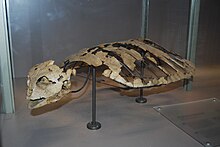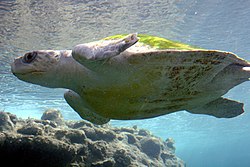| Allopleuron Temporal range: Late Cretaceous–Oligocene 94.3–28.4 Ma PreꞒ Ꞓ O S D C P T J K Pg N | |
|---|---|

| |
| Fossil specimen, Royal Belgian Institute of Natural Sciences | |
| Scientific classification | |
| Domain: | Eukaryota |
| Kingdom: | Animalia |
| Phylum: | Chordata |
| Class: | Reptilia |
| Order: | Testudines |
| Suborder: | Cryptodira |
| Superfamily: | Chelonioidea |
| Family: | Cheloniidae |
| Subfamily: | †Allopleuroninae |
| Genus: | †Allopleuron Baur, 1888 |
| Type species | |
| Chelonia hofmanni Gray, 1831 | |
| Species | |
| |
Allopleuron (meaning "other side") is a genus of extinct sea turtle, which measured 2-to-2.5-metre (6 ft 7 in to 8 ft 2 in) long in life. The type species is Allopleuron hofmanni. It is a basal member of the clade Pancheloniidae, closely related to Protosphargis. Similar to Protosphargis, it was characterized by shell reduction.
Fossil history


Allopleuron lived from the Late Cretaceous (Cenomanian age, 94.3 Ma) to the Oligocene (Rupelian age, 28.4 Ma), therefore surviving the Cretaceous-Paleogene extinction event. Fossils have been found from Germany, the Netherlands, Kazakhstan and the United States.
Life history
Allopleuron was believed to have used the Laurasian-Holarctic southern continental shelf as a breeding area. The modern day location of the breeding ground is along the coast of Asia. Allopleuron is believed to have eaten jellyfish, seaweed, or carcasses; A. hofmanni δC values indicate a carnivorous diet. It is believed that adult male Allopleuron lived off the coast of southeast Netherlands, and northeast Belgium due to the large amount of fossils in these areas. The area is believed to have been a sea grass meadow that was able to sustain the large population. The lack of remains from juvenile Allopleuron indicate that the young of the species lived elsewhere.
Phylogeny
Evers et al. (2019):
| Panchelonioidea |
| ||||||||||||||||||||||||||||||||||||||||||||||||||||||||||||||||||
References
- ^ Hans-Volker Karl; Elke Gröning; Carsten Brauckmann (2012). "New materials of the giant sea turtle Allopleuron (Testudines: Chelonioidea) from the marine Late Cretaceous of Central Europe and the Palaeogene of Kazakhstan". Studia Palaeocheloniologica IV, Studia Geologica Salmanticensia. 9: 153–173.
- Gray, J.E. (1831), Synopsis Reptilium, Part I: 54 and 79
- ^ Evers, Serjoscha W.; Barrett, Paul M.; Benson, Roger B. J. (2019-05-01). "Anatomy of Rhinochelys pulchriceps (Protostegidae) and marine adaptation during the early evolution of chelonioids". PeerJ. 7: e6811. doi:10.7717/peerj.6811. ISSN 2167-8359. PMC 6500378. PMID 31106054.
- Hirayama, Ren (2005). "SYSTEMATIC POSITION OF PROTOSPHARGIS VERONENSIS CAPELLINI, AN ENIGMATIC SEA TURTLE FROM THE LATE CRETACEOUS OF ITALY". Journal of Vertebrate Paleontology (25): 70A.
- "Fossilworks: Allopleuron". fossilworks.org. Retrieved 17 December 2021.
- ^ Universidad de Salamanca, Ediciones (2013-12-20). "Índice". Studia Historica. Historia Moderna. 35: 1. doi:10.14201/11405. ISSN 0213-2079.
- "Marine Turtles". oceansofkansas.com. Retrieved 2019-05-05.
- van Baal, Remy R.; Janssen, Renée; van der Lubbe, H.J.L.; Schulp, Anne S.; Jagt, John W.M.; Vonhof, Hubert B. (15 December 2013). "Oxygen and carbon stable isotope records of marine vertebrates from the type Maastrichtian, The Netherlands and northeast Belgium (Late Cretaceous)". Palaeogeography, Palaeoclimatology, Palaeoecology. 392: 71–78. doi:10.1016/j.palaeo.2013.08.020. Retrieved 1 December 2024 – via Elsevier Science Direct.
| Taxon identifiers | |
|---|---|
| Allopleuron | |
| Allopleuron hofmanni | |
| Cheloniidae family | ||||
|---|---|---|---|---|
| ||||
| Genera |
|  | ||
| †Allopleuron | ||||
| †Argillochelys | ||||
| Caretta | ||||
| †Carolinochelys | ||||
| Chelonia | ||||
| †Eochelone | ||||
| Eretmochelys | ||||
| †Gigantatypus | ||||
| †Glarichelys | ||||
| †Itilochelys | ||||
| Lepidochelys | ||||
| †Mexichelys | ||||
| †Miocaretta | ||||
| Natator | ||||
| †Pacifichelys | ||||
| †Syllomus | ||||
| †Tasbacka | ||||
| Phylogenetic arrangement of turtles based on turtles of the world 2017 update: Annotated checklist and atlas of taxonomy, synonymy, distribution, and conservation status. †=Extinct. | ||||